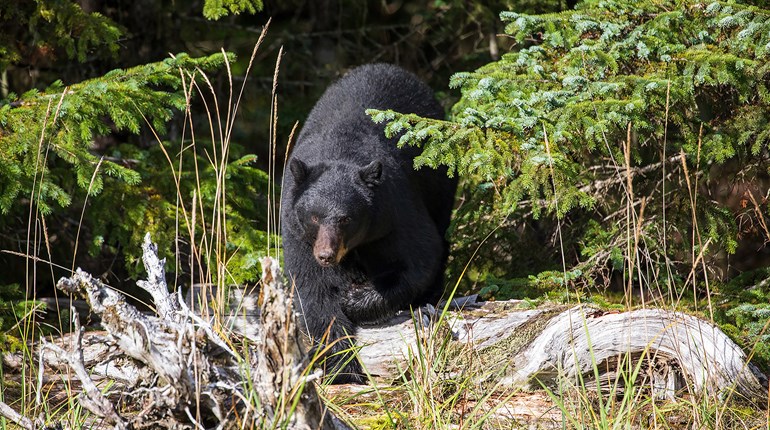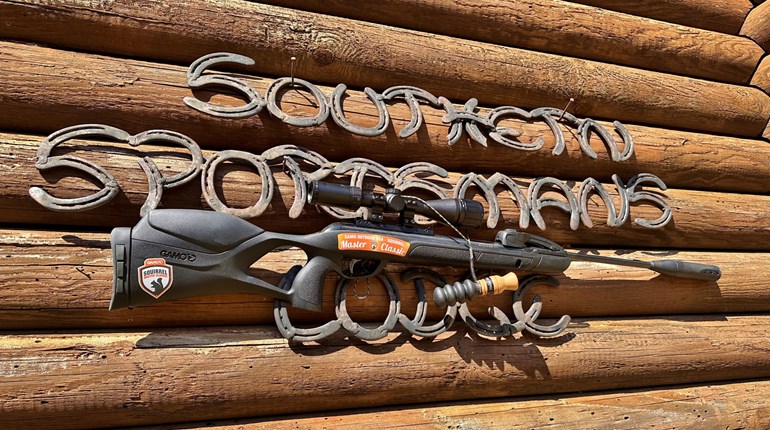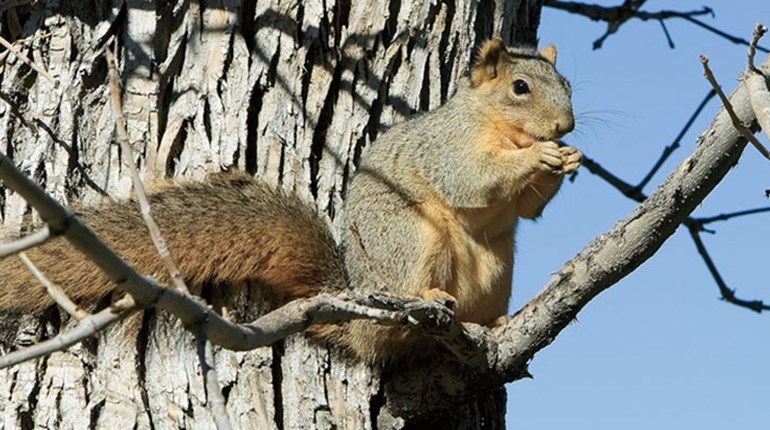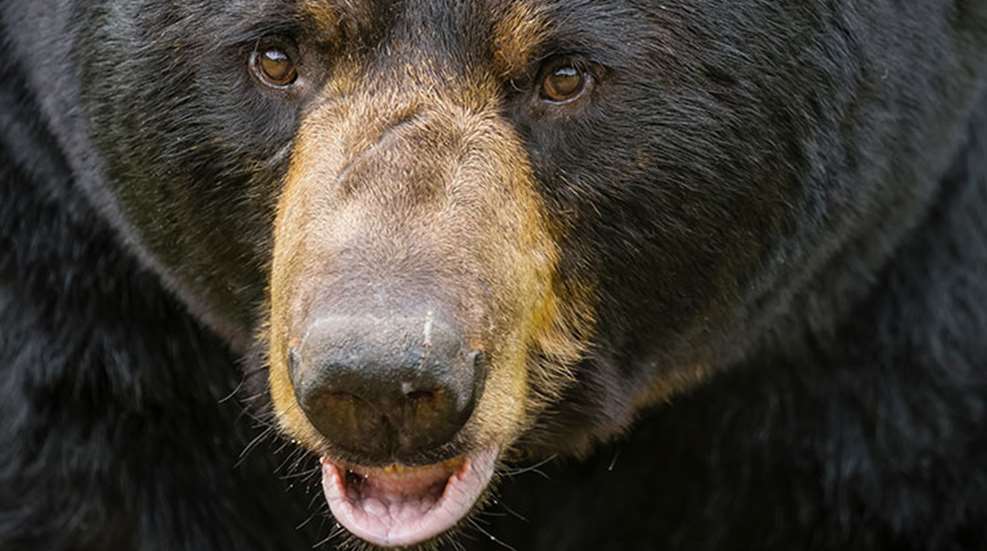
Alaska is a wild place. It has millions of acres of pristine wilderness and wildlife, including a lot of bears. Alaska is blessed with black bears, brown bears (the inland grizzly and the larger coastal brown bear) and the polar bear. Most of the time many of these bears are not a problem, but on certain days they may try to kill you. Dealing with these apex predators is part of living on the Last Frontier. And of course it’s also part of any hunter’s life who hunts, scouts for game or camps in bear country.
It’s also routine for those who regularly work in the bush. Alaska DNR, Alaska Fish and Game, U.S. Bureau of Land Management and U.S. Geological Survey workers are among those who may spend a lot of time in remote country. In 1978, a geologist working for the USGS was attacked and severely mauled by a predatory black bear in the Yukon wilderness. Cynthia Dusel-Bacon lost both arms as a result of the attack but went on to recover and finish her career with the USGS.
The attack led a coworker of Dusel-Bacon, Steve Nelson of Anchorage, to create and begin teaching a bear defense and awareness class. Nelson has since retired from the USGS but still teaches his class; to date he has taught hundreds of state, federal and private company personnel as well as individuals who want to be better prepared for a bear attack. Nelson has had occasion over the years to shoot two black bears and two brown bears in DLP situations—which means in “defense of life or property.”
In 2017, I attended Steve Nelson’s class along with personnel from Alaska DNR, Alaska Fish and Game, the USGS and others. The class is heavily based on firearm training for bear encounters, but instructors also stress bear awareness and bear behavior. Knowing how a bear may behave and how to read its body language is all part of the equation of surviving an encounter with a bruin that may be having a bad day. Bears, like any animal, experience stress and have various forms of behavior to show it. Bear experts generally place most bear attacks in one of two categories: defensive and predatory.
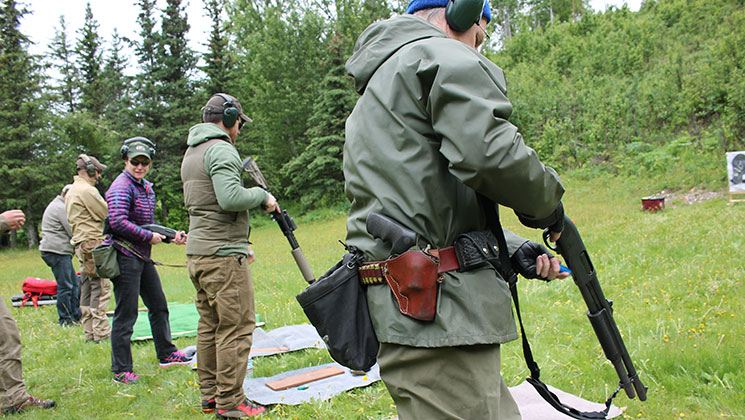
Defensive Bear Attacks
“Most bear attacks we see are defensive in nature,” says Nelson. “The bear is defending something such as a fresh kill or other food source, its territory—and this may happen if you surprise a bear at close range, or it might be defending cubs.” Surprising a bear at close range, a bear that did not know you were in the area, seems to be a common cause of attacks. For this reason the instructors advise to make plenty of noise if you think there may be a bear nearby.
A bear in defensive mode may start by yawning and/or salivating then move on to foot stomping and swatting the ground. As it becomes more agitated, the bear may exhibit head swaying and teeth popping or “clacking,” which can be surprisingly loud and is thought to be a sign of fear. At this point a bear in defensive mode may leave the area—and they often do. If not, the bear may take it to the next level and initiate one of three types of charges.
Bears may display a mock or bluff charge characterized by a short “woof,” like a dog, then make a quick lunge toward you. The bear may then circle back to its original position. This may be repeated several times. In a bluff charge, the bear’s ears are usually erect and the muzzle is pointed toward you. Bluff charges are almost never associated with actual contact.
In an actual charge, the bear means business and has decided to take you apart at the seams. The bear’s nose usually will be pointed downward, its ears will be flattened back and its hackles (the fur on the top of its neck) likely will be raised. Nelson and instructors Mike Harrington, with Alaska Fish and Game, and Matt Sexson, with USGS, stress that we must remember this would occur at blinding speed. Most reported bear charges start from about 50 yards away. A charging bear covers 15 yards a second. Do the math: A bear charging from 50 yards will be on you in less than 4 seconds. This is why Nelson spends so much time on the range emphasizing familiarization and speed with your firearm.
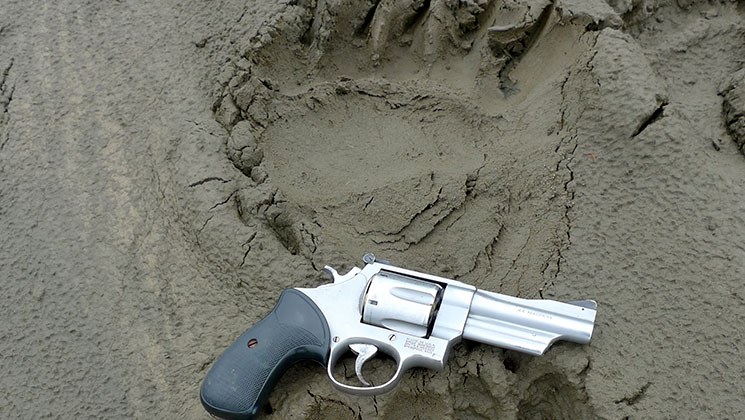
Predatory Bear Attacks
A predatory bear attack starts very differently from a defensive one. A predatory attack is just that: This bear is stalking you as prey. While predatory bear attacks in Alaska number far fewer than defensive attacks, it’s interesting to note most predatory incidents occur with black bears. Why predatory black bear attacks are so much more common in Alaska than the Lower 48 no one seems to know. Predatory black bears are almost always large males.
The behavior and posture of a predatory bear will be quite different than that shown by a bear on defense. A predatory bear may appear quiet and intently focused on you, almost as if he were just curious (which can make this form of attack all the more sinister). This bear may follow you for a great distance and weave in and out of cover, at times seeming to hide from you. Most bear experts advise you to leave the area if confronted with this bear, keeping a close watch on him at all times. If you are in a group come together to appear larger if the bear approaches. If the bear makes a move on you stand firm. Do not run. Remember the 15 feet per second? Yell at the bear in a firm voice. Use whatever deterrents you have on hand—bear spray or firearms. After a week with Nelson and his crew in Alaska, I vote for a gun.
The curious bear aspect needs to be mentioned here. Bears reportedly have the largest brain of all predators, and they appear to be very intelligent. Bears can be very curious; this may get the bear and you into trouble. A bear may approach you initially seeming to be only curious, but after coming closer curiosity can turn into the defensive mode or even predatory mode.
Nelson relates an incident where along with a hunting buddy he landed a motorized skiff on a remote beach in Prince William Sound. “When we came out of the woods a short time later a black bear was at the boat. It appeared be very curious, as if it might jump into it,” he says. (Bears, by the way, seem attracted to petroleum products.) “Because I had my friend as a backup, I decided to fire a warning shot to make the bear leave. At the shot the bear ran directly at us and came so close I thought my friend would shoot him, but the bear veered away at the last second.” For this reason and others Nelson does not recommend warning shots. “I find they are not usually effective and may provoke a charge rather than prevent one,” he says.
Matt Sexson, bear defense and firearm trainer for the USGS, has some good advice for those working in bear country, as his people do routinely.
“Our bear safety program focuses on three components. Respect: Like people, bears have space and resource requirements; respect those aspects of their ecology. Knowledge: Learn about bear behaviors, patterns; bear density wherever you plan to work or play, which will also depend on the time of year. Awareness: Stay alert in the field; always scan your area; make noise; and do not become complacent when everything is quiet and going well.”
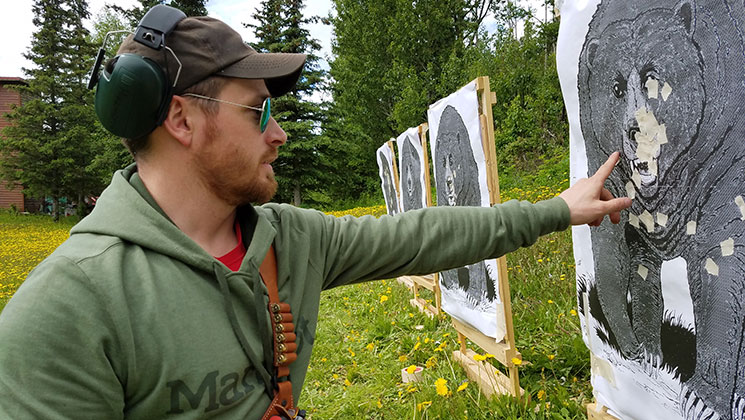
Firearm Training
“The purpose of the Bear Awareness, Bear Avoidance, and Firearms Safety class is to promote safety and security of field personnel in Alaska,” says Nelson. He averages about a hundred students a year from agencies like Alaska DNR, Alaska Game and Fish, USGS, BLM, numerous companies that do business all over Alaska and many individuals who want to be better prepared in bear country. In the classroom and on the shooting range he focuses on firearm safety and familiarization. Being familiar with your firearm and developing good gun-handling skills will make all the difference if confronted with the ultimate stress level of being charged by a brown bear the size of a minivan.
During the firearm component of the class, Nelson is not afraid to keep students on the firing line, to repeat gun-handling drills and to burn a lot of ammo. This is exactly the kind of exercise needed to make you more proficient with your firearm. Even though this is Alaska, Nelson and others get students with all levels of experience with firearms; sometimes instructors must start at the beginning with safety and gun-handling skills.
Safety must be emphasized. In the Alaska bush, when you are a hundred miles from nowhere with little or no communication with the outside world, things can go downhill fast if you have an accident with a firearm.
“In this class, we cover ways to carry in the field when working with others,” says Mike Harrington, firearm and bear-defense instructor for the Alaska Department of Fish and Game. “An example would be two fisheries biologists walking up a stream, single file, both carrying pump-action shotguns. Before any training they would commonly carry both with rounds in the chamber and safeties on. I taught them a safer way, which is having the second person carry with their action loose, safety off. If a bear charged all this person would have to do is cycle a round into the chamber and engage the bear.”
The firearm portion of the class culminates with a charging-bear target exercise, and it is, to say the least, exciting. While nothing may compare to an actual bear attack with a bruin coming at you at 30 mph, a bear target speeding toward you will induce a certain level of stress. In this event the bear charge happens from approximately 50 yards, providing the shooter less than 4 seconds to engage it. Again, this teaches the importance of gun-handling skills.
A basic concept is the aspect of just being “ready.” Anyone who works or plays in bear country may see long hours of hiking and work-related tedium where it is quite easy to let down one’s guard. While in bear country, the threat of a confrontation is always there even if no bear is visible. Staying mentally aware of this and having a firearm or other deterrent on hand could save your life.
On another trip to Prince Edward Island, Nelson was walking on the beach and noticed a black bear about a hundred yards away. The bear retreated into the woods as Nelson thought it would. “When I reached the area where the bear had run off, I don’t really know why but I took my revolver, a Ruger Super Redhawk .44 Magnum, out of the holster. Within a few seconds I heard the brush breaking and turned to see a black bear running at me from about 15 yards away. I only had time to bring up the weapon and fire one shot, which hit the bear between the shoulder blades and brought him down. I am not sure I would have been able to react in time had I not had the Ruger in hand.”
Bear Spray vs. Firearm
One of the controversies in the area of bear defense concerns using bear pepper spray or firearms. The active ingredient in pepper spray, capsaicin, may be higher in sprays meant to deter bears than those meant to deter humans. Still, many in Alaska are skeptical about how effective bear spray is at times. Several jokes are told in the bush about pepper spray being a condiment.
“I am not a strong supporter of pepper spray,” says Nelson. “In certain conditions I would use it such as a bear mauling or on any bear coming into a tent in a camp situation. It is important to know that spray residue is a bear attractant. For the mauling situation, to start shooting before the bear is off the victim is very risky; using the spray will likely result in the bear leaving the victim and allowing the shooter a safer chance to shoot.” The transport of pepper spray on aircraft is also an issue, he says. Some charter operators may refuse to allow pepper spray in or on their aircraft because of the potential to incapacitate the pilot and the fire hazard posed by the flammable solvents used in bear spray. “I have also found elevation can impact the performance of spray,” says Nelson. “At 7,000 feet, the spray would only travel about 10 to 12 feet.”
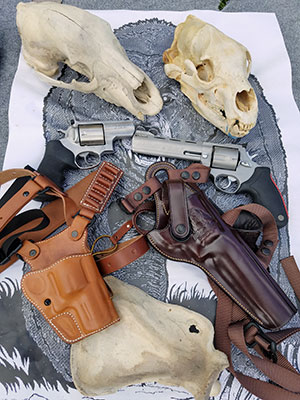 I also heard from Nelson and others in the class that bear spray may deliver questionable results in other conditions; freezing temperatures affect the spray’s performance, as does rain and a strong crosswind. There are many reported incidents where bear spray worked; there are also several where it did not. In researching this topic I often saw responses from those who advocated the use of spray and not guns, explaining that deploying spray during a bear charge is much faster than a firearm. It would seem if you have time to fire a can of pepper spray you have time to fire a gun.
I also heard from Nelson and others in the class that bear spray may deliver questionable results in other conditions; freezing temperatures affect the spray’s performance, as does rain and a strong crosswind. There are many reported incidents where bear spray worked; there are also several where it did not. In researching this topic I often saw responses from those who advocated the use of spray and not guns, explaining that deploying spray during a bear charge is much faster than a firearm. It would seem if you have time to fire a can of pepper spray you have time to fire a gun.
Nelson actually recommends his students carry bear spray, along with a firearm. He also advocates the use of a marine signal flare as a non-lethal deterrent; a flare has a greater range than spray and is less affected by rain and wind. He cautions, however, that use of a flare in very dry conditions may start a fire.
“Our goal in the firearm training isn’t to debate which deterrents are better but to train those who choose to carry firearms to be safe and have the skills to deal with an aggressive bear.”
Conclusion
Anyone who lives in the somewhat tame landscape of the Lower 48 may find it hard to grasp the idea of being attacked by a bear, or any wild animal, but it happens. News reports describe these incidents as “uncommon” or “rare,” but are they?
In 2016 in Alaska, there were at least 64 incidents of bears being shot under DLP guidelines. Not all of these bears were attacking someone, but they were shot by Alaska Fish and Game or DNR personnel, police officers or private citizens. These are just the incidents that were reported. The first week I was in Alaska last June, there was some sort of bear incident every day. Either there was a mauling, or a bear or bears were shot for DLP reasons. Sadly, there were two fatalities. Both fatalities, by the way, involved black bears, and both attacks were thought to be predatory in nature. Alaska is a wild place, and I believe there will be a need for bear-defense classes there for a long time.
Bear Training
Steve Nelson teaches “Bear Behavior, Bear Avoidance, and Firearms Safety” to about 150 students per year in Alaska from February-June. Those interested in the training may contact him at [email protected].












